

Evolution of The Next Generation’s Shuttlecraft
Since The Next Generation was set a century after the original Star Trek , not only the Enterprise but its shuttlecraft had to be upgraded as well. The job of designing a twenty-fourth-century shuttle was Andrew Probert’s, who also designed the series’ flagship.
Much like the design of Probert’s Enterprise flowed from Matt Jefferies’, he looked to the Shuttlecraft Galileo of The Original Series for inspiration. “My new shuttle was an attempt at correcting the size of what we know as the Galileo 7 , where in the actual vehicle you had to bend over to get in and out,” he told Greg Tyler of Trekplace in 2005.
I studied the interior while watching “Galileo Seven” footage, and the top of the door is actually at Leonard Nimoy’s nose, so he has to bend over to go through the door, but when you go to the exterior, the ship is much smaller, so that his bent-over attitude sort of cuts together nicely. I wanted to correct all of that. I wanted to design a shuttle that they could actually stand up in and walk out of vertically.
In an effort to make the new shuttle visually more interesting, Probert’s first plan was to put the entrance in the front.
He explained in an interview with Star Trek: The Magazine in 2001, “There’s a ramp that lowers between the two operators. The top portion of that would actually slide up, much like a sunroof does on a car, allowing the people to walk straight up into the shuttle between the operators.”

The producers liked the idea, but it proved too ambitious. “They built a shuttle that basically had square edges on it,” said Probert. “Then they came up with the idea of getting into the shuttle from the side.”

The model, which first appeared in “Coming of Age”, was even boxier. Although it was still somewhat reminiscent of the Enterprise -D’s curved lines, Probert was disappointed and called the final product a “Winnebago” (an American recreational vehicle) in his interview with Tyler.
A final modification was made to the windows. The original model had them running across the length of the shuttle, which would have interfered with the side entry. The original configuration was sometimes seen in Season 1 computer displays.

Probert used he longer windows in an artwork he made for a model kit of the pod, which also appeared in the 2013 Ships of the Line calendar.
Bernd Schneider details the appearances of Probert’s original shuttlecraft, which came to be known as the “Type 7”, as well the various incarnations of its cockpit, at Ex Astris Scientia .
After Probert left The Next Generation , Rick Sternbach was tasked with designing an alternative shuttle for the Season 2 episode “Time Squared”. He recalled in an interview with Star Trek: The Magazine in 2002:
Everybody was kind of scratching their heads and thinking that maybe we’d have to write the shuttlepod out. I cautiously went up to the front of the room with this very rough but fairly clear sketch. I said, “What if we made it fairly simple? Just planer construction, no compound curves. We can make it look Starfleet; that isn’t the issue. If we do something like this we can make the construction simple but also make it interesting.” They all looked at me, looked at the sketch, and said, “Ah, OK.” Then they approved it.

This new shuttle, dubbed “Type 15”, was smaller, which made it easier to construct a life-sized mock-up.

As with the Type 7, the Type 15 shuttle underwent several changes in both its exterior and interior over the course of The Next Generation . Bernd Schneider has the details at Ex Astris Scientia .
By the fifth season, The Next Generation ’s shuttle complement was joined by the larger “Type 6”, which was a redress of the shuttlecraft that had appeared two years earlier in Star Trek V: The Final Frontier .
“We made use of one of the Trek V shuttles by chopping a section out of the middle and giving it new engines and windows,” Sternbach told Forgotten Trek in 2007 .
The great thing about it and most of the other Starfleet shuttles we built was the fact that where there are curves, the curves follow a single bend and “softening” the joined edges is no big deal. It was much easier to do the real set pieces that way, even if we did migrate to some ships that had no exteriors except for CGI.

A miniature version was built by Ed Miarecki to appear in the model of the ship’s main shuttlebay in “Cause and Effect”, although it was barely visible on screen.

A new miniature was built under the supervision of Greg Jein, which first appeared in “Parallels”. Unfortunately, stock shots from the Type 7 were repeatedly used and paired with Type 6 interiors, an inconsistency that continued into Star Trek: Voyager .
“A miniature version was built by Ed Miarecki to appear in the model of the ship’s main shuttlebay that was seen in Season 5’s “Cause and Effect”.” But didn’t that episode only show two Type-6 shuttles (named Berman and Piller I believe) in the main shuttlebay? “Unfortunately, stock shots from the Type-7 were repeatedly used and paired with Type-6 interiors, an inconsistency that continued into Star Trek: Voyager .” But Voyager did it with Type-6 and Type-8. Yeh, completely different I know, but still…
Maybe you can help. I bought a playmates Star Trek TNG shuttlecraft and I wanted to repaint it to look more screen accurate. I’ve been looking for days on Google and am struggling to find paint colors. Eventually once I’m confident I want to add lights to the interior as well as adding LEDs to the warp nacelles. Thanks.
believe the correct color for the shuttles is a light tan. The shuttles compliment the interior colors of the Enterprise -D as opposed to its exterior, which was blues and greens. The color you want is likely to be found on a Federal Standard (FS) paint chart (they’ll be lots of similar colors on there) and there are firms who can make you an aerosol if you can’t find the color ready made in hobby paint (or don’t want to mix your own, by adding lots of white as most off-the-shelf colors are too dark). However, under studio lighting, a lot of colors look washed out to a pale grey. Tamiya Insignia White AS20 is a great off-the-shelf option for TNG and Voyager shuttles, as it’s a light grey/off white, with a warm tint. It’s not accurate to the original miniature or full-size mockup, but it looks good in most indoor lighting and perhaps better than a light tan that is too dark. I’m using AS20 on one of my shuttlecraft projects and I’ve been quite happy with it, as in most of the scenes in the episodes, the shuttle I’m building looks bleached out under the studio lighting.
Thanks! I’d love to see how yours turned out.
Thanks I’ll post it on YouTube once finished. I’m getting there with my Type 15, lower half is assembled and painted with nacelles attached, upper half is assembled but not yet painted, I’ve got some lighting to do and panels to make for the touch screen displays. The Tamiya Insignia White looks great and I expect it will yellow slightly once the varnish goes on. Though I’ve since found that there was a kit of the Type 7, which had involvement with Andrew Probert, the instructions call for FS37722 as the paint code for the hull color, again its a warm light grey with some tan color in there.
Submit comments by email .
Type-7 Personnel Shuttlecraft
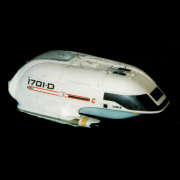
- Type: Medium short-range warp shuttle.
- Accommodation: Two flight crew, six passengers.
- Power Plant: One 150 cochrane warp engine, two 750 millicochrane impulse engines, four RCS thrusters.
- Dimensions: Length, 8.5 m; beam, 3.6 m; height 2.7 m.
- Mass: 3.96 metric tones.
- Performance: Sustained Warp 4.
- Armament: Two Type-V phaser emitters.
With the borders of the Federation ever expanding as Starfleet reached the latter half of the 24th Century, the ASDB realized that there was sufficient need for a shuttlecraft capable of making the week-long journeys between planets and stations at low warp. The Type-7 was the first step in this direction, and is equipped for short-range warp travel. To offer comfort to its occupants, the shuttle contains a standard replicator system and sleeping compartments. The forward and aft compartments are separated by a small, informal living area that has a workstation and table. The aft area is normally equipped with a bunk area, but can easily be converted to allow for increased cargo capabilities. A medium-range transporter and atmospheric flight capabilities allow for the Type-7 to service starbases, starships and stations. Ships of this type are currently in use aboard most medium to large sized starship classes, as well as aboard stations and Starbases.
Major technological advancements in the 2370’s allowed for further upgrades to be made to the engine systems aboard shuttlecraft. These upgrades make this craft more capable of long-range spaceflight and, like its starship counterparts, no longer damages subspace.
- Engineering
- Federation Support Craft
Navigation menu
Personal tools.
- Not logged in
- Contributions
- View history
- Recent changes
- Random Image
- Random Article
Popular Wiki Pages
Retired or destroyed.
- USS Templar
- USS Paladin
- USS Rosenante
- USS Boudicca
- USS Cochrane
- USS Firebrande
- USS Dennison
- USS Champlain
- USS Mithrandir
- USS Mystique
- USS Starfire
- USS Spectre
STF History
- What links here
- Related changes
- Special pages
- Printable version
- Permanent link
- Page information
- Cite this page
- This page was last edited on 18 January 2009, at 09:03.
- Privacy policy
- About Star Trek : Freedom's Wiki
- Disclaimers

Type 7 Shuttle
Personnel Shuttles
Personnel Shuttles are the most common form of auxiliary craft used by Starfleet . Made for short-duration missions, these craft generally have warp capability that limits them to an effective range of only a few light-years from their mothership or base, and they typically can accommodate between four and eight people, including their crew. They are most effective at travel within the same star system. While the distinction between personnel shuttles and shuttlepods has shifted over time and can be somewhat fuzzy, personnel shuttles are generally larger and warp-capable while shuttlepods are smaller and limited to impulse speeds.
- 1 Type-4 Shuttle
- 2 Type-5 Shuttle
- 3.1 Type-6A Shuttle
- 4 Type-7 Shuttle
- 5 Type-8 Shuttle
- 6 Type-9 Shuttle
- 7 Type 10 Shuttle
- 8 Type-11 Shuttle
- 9 Type 12 Shuttle
- 10 Type-14 Shuttle
Type-4 Shuttle
The Type-4 Shuttle is based on the earlier Class-C shuttlecraft, a design that is also still seen in widespread use across the Federation. Its basic spaceframe has served as the core of the later Type-5, Type-6, and Type-8 designs, a line of vehicles that has seen production in the hundreds of thousands since it was first introduced in the 2280s. Generally speaking, these are no longer used by Starfleet, though there are exceptions hanging on at remote outposts and assigned to vessels in the Starfleet Auxilary, such as freighters and tankers. They still see widespread use in civilian hands.
The forward cockpit with two crew stations is separated from the aft passenger area by a section with doors to port and starboard that allow entry to the cabin. Entry is also possible through a large hatch on the aft end of the vehicle. Generally, the aft area contains bench seats on either side, though there are variants with these stripped out to carry more cargo, variants with chairs, and even VIP variants; because of this vehicle's extreme age, there are many variants that could be encountered.
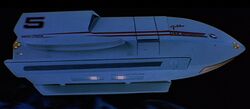
Type-5 Shuttle
The Type-5 shuttle is an evolution of the earlier Type-4 design with an enhanced cockpit and other improvements to the general characteristics of the craft. It has been in service for over sixty years at this point and is generally found on older vessels and on unimportant space stations. It's often used as a flight trainer, given its commonality with so many other small Federation vehicles.
The forward cockpit with two crew stations is separated from the aft passenger area by a section with doors to port and starboard that allow entry to the cabin. Entry is also possible through a large hatch on the aft end of the vehicle. Generally, the aft area contains bench seats on either side, though there are variants with these stripped out to carry more cargo, variants with chairs, and even VIP variants; because of this vehicle's extreme age, there are many variants that could be encountered. Unlike the earlier model, it has an emergency transporter.
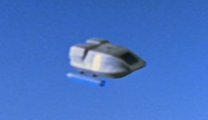
Type-6 Shuttle
Of all of the models of shuttle produced in the 24th century, the Type-6 is the most common throughout Starfleet. Though it was introduced in the 2350s, it was produced in such high numbers that it will be a common sight in hanger bays across the fleet for the foreseeable future. Many pilots prefer this craft over later models because it strikes such a good balance between size and performance.
A shortened and enhanced version of the two previous models, this craft has an emergency transporter, replicator, and mounts for type-VI phaser banks which can be installed for special missions. With the two side hatches from the previous versions eliminated, access is only possible through the large rear hatch. Bench seating on the sides of the aft compartment is the most common configuration for this shuttle.
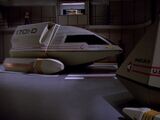
Type-6A Shuttle
Introduced alongside the California -class starship in 2368, the Type-6A shuttle incorporates all of the technical advancements of the Type-6 shuttle while returning to the fuselage length of the Type-5, once again featuring a pair of gull-wing doors between the cockpit and passenger/cargo compartment. This larger size allows it to reliably transport bulkier cargo, useful for ships not large enough to also carry cargo shuttles. The Type-6A is slightly taller than the model it is derived from, as it rests on its warp nacelles and not the bottom of the fuselage.
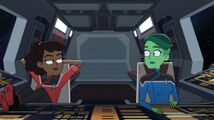
Type-7 Shuttle
Introduced alongside the Galaxy-class in the late 2350s, the Type-7 shuttle was the first wholly new personnel shuttle design in over 70 years. With its curved hull and spacious interior, it was a much higher performance vehicle than the Type-6 and generally has only seen service on larger vessels. It still remains a popular small craft, especially among senior officers who appreciate the separation between the flight area and the passenger compartment. Its production ended with the advent of the larger and more capable Type-11 shuttle.
Entry is provided through a hatch under the nose of the vehicle, which also serves as a ramp up into the cockpit, which contains free-standing consoles for a pilot and mission specialist. It has reconfigurable seating in the aft compartment that can serve in many variations ranging from bench seating for six, to front-to-back chairs for eight, to an executive configuration with a comfortable lounge space for senior officers.
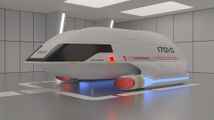
Type-8 Shuttle
The most recent (and likely final) revision of the Type-4 spaceframe, the Type-8 shuttle is an uprated version of the Type-6, with enhanced computer systems, shields, and Type-VI phasers mounted by default, as a response to increasing concerns over the Borg that were circulating when it was introduced in the late 2360s. It was first used aboard Akira, Saber, and Norway-class ships, and retains the same overall shape and configuration of her older cousin. Though it's not meant for sustained combat, commanders can feel confident that it can get where it needs to go thanks to its adequate defenses.
This craft has an emergency transporter and replicator, and access is only possible through the large rear hatch. Bench seating on the sides of the aft compartment is the most common configuration for this shuttle.
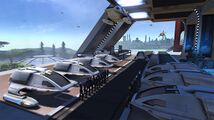

Type-9 Shuttle
Designed alongside the Nova -class starship , the Type-9 shuttle is very fast for its size and is ideal for short-range scouting missions away from its mothership. It is armed with three Type-VI phaser arrays and has good shielding, but only has comfortable accommodations for four people, including two crew. It remains a common sight due to its utility, though it's less capable of transporting people than larger models. It is no longer in production, with the updated Type-12 now available.
The cockpit has a station for the pilot and a station for a mission specialist, which includes a large wrap-around console with access to the shuttle's enhanced sensor systems. Entry is provided through an aft hatch, which has a fold-down ramp and a roll-up upper section. Jumpseats can be installed in the aft section, or the shuttle can carry small amounts of cargo.
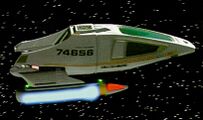
Type 10 Shuttle
The Type-10 shuttle is a combat-capable personnel transport suited for missions in dangerous areas. Designed for escort-type ships such as the Defiant-class, these craft take up a minimal amount of space and have hardened features. In addition to an armored hull, they're armed with Type-VI phaser arrays and twin micro-torpedo launchers mounted above the fuselage. These armaments make them an ideal choice for discreet tactical missions. They have the capacity for two crew members and four passengers. Entry is achieved through a single rear hatch, and this craft is one of the few Federation vehicles that has extendable landing legs to offer stability for its rear-heavy frame.
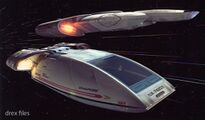
Type-11 Shuttle
Type-11 shuttles are large personnel shuttles intended for true interstellar travel. Built on similar principles to the earlier Type-7 shuttle but on a larger scale, this type of shuttle has a separate cockpit and configurable mission section, with options ranging from simple passenger space, a VIP stateroom, cargo space, or scientific equipment. This modularity makes it nearly as capable as a small runabout, and, indeed, smaller ships will often embark a Type-11 rather than a runabout. They have a single aft hatch, along with top and bottom hatches with docking clamps. They're also armed standard with Type-VII phaser arrays. This type is no longer in production, as it has been succeeded by the similar but more advanced Type-14 shuttle.
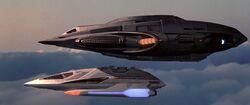
Type 12 Shuttle
Introduced in the early 2390s, the Type-12 shuttle is an upgrade to the Type-9 shuttle, with even faster engines and enhanced tactical systems (Type-VIII phaser arrays and two micro torpedo launchers). It is currently the standard personnel shuttle being deployed across Starfleet's newest ships and bases. Capable of even longer distance missions than the Type-9, the Type-12 is a highly capable craft that also fits in almost any hanger bay.
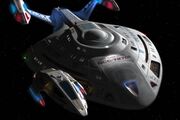
Type-14 Shuttle
Type-14 shuttles are the largest and most advanced personnel shuttles in service as of 2400. Like the earlier Type-11, they are configurable with options ranging from simple passenger space, a VIP stateroom, cargo space, or scientific equipment. They are just as capable as small runabouts for most missions, and are even used for long-distance journeys thanks to their high top speed. They retain from the Type-11 shuttle a single aft hatch, along with top and bottom hatches with docking clamps, as well as the same phaser armament. In addition, they have microtorpedo launchers fore and aft, allowing them to defend their VIP passengers.
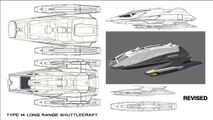
- Bravo Fleet Canon
- Specifications
- Federation Small Craft Classes
- Auxiliary Craft
- Federation Small Craft

Federation shuttlecraft
- View history
List of named Federation shuttlecraft .
- 1 USS Cerritos
- 2 USS Defiant (NX-74205)
- 3 USS Discovery
- 4 USS Discovery -A
- 5 USS Enterprise (NCC-1701)
- 6 USS Enterprise (NCC-1701) (alternate reality)
- 7 USS Enterprise (NCC-1701-A)
- 8 USS Enterprise (NCC-1701-D)
- 9 USS Enterprise (NCC-1701-E)
- 10 USS Kelvin
- 11 USS Protostar
- 12 USS Titan
- 13 USS Titan -A
- 14 USS Vancouver
- 15 USS Voyager
- 16 Miscellaneous
- 17 Unnamed and unnumbered
- 18.1 Background information
- 18.2 External link
USS Cerritos [ ]
Uss defiant (nx-74205) [ ], uss discovery [ ], uss discovery -a [ ], uss enterprise (ncc-1701) [ ], uss enterprise (ncc-1701) (alternate reality) [ ], uss enterprise (ncc-1701-a) [ ], uss enterprise (ncc-1701-d) [ ], uss enterprise (ncc-1701-e) [ ], uss kelvin [ ], uss protostar [ ], uss titan [ ], uss titan -a [ ], uss vancouver [ ], uss voyager [ ], miscellaneous [ ], unnamed and unnumbered [ ].
- See : Unnamed Federation shuttles
Appendices [ ]
Background information [ ].
Multiple concept sketches of Federation shuttles designed for Star Trek Beyond can be seen at Trekcore. [1] [2]
External link [ ]
- Federation shuttlecraft at Memory Beta , the wiki for licensed Star Trek works
- 1 Rachel Garrett
- 3 USS Enterprise (NCC-1701-G)

- Ship interiors by class:
- - Akira Class
- - Ambassador Class
- - Constellation Class
- - Excelsior Class
- - Galaxy Class
- - Mediterranean Class
- - Norway Class
- - Perseverance Class
- - Prometheus Class
- - Ross Class
- - Saber Class
- - Steamrunner Class
- Starbase Interiors:
- - Fontana Station
- Older Sci-Fi Interiors
- Other 3D Stuff
- Uniform Design
- Other 2D Stuff
- Site Updates
- Contact Form
Type-7 Shuttlecraft

Developed in the 2350's with technology from the Galaxy project, the Type 7 was a radical departure in established Starfleet shuttlecraft design. Larger than the commonplace Type 6, it featured a forward entrance ramp between the two viewing windows, more cabin space and far more powerful warp engines.
Originally only intended to be used on Galaxy project-related starships (such as the Nebula, Challenger and New Orleans classes) and brand new stationary installations, it eventually saw limited service in older starships and stations. However its large size and complex construction limited its possible uses, and it was quickly superseded by more practical and easy to deploy shuttle designs.
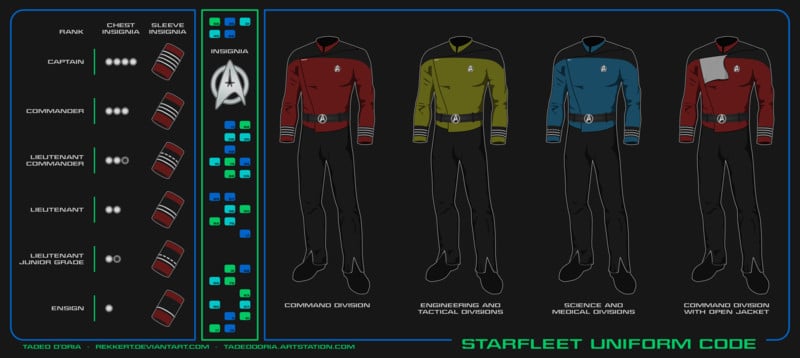
- description Content
- person User
- More to Explore
- Series & Movies
Published Aug 18, 2011
The Shuttlecraft Galileo - Part 1
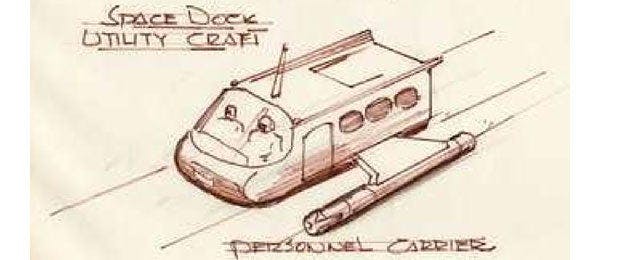
Today, in our guest blog, Star Trek enthusiast Steve Thomas chronicles the real-life travails of Star Trek's iconic shuttlecraft, the Galileo 1701/7. This is part one of an extensive two-part feature that includes photographs and video.
September 8, 1966…or “Stardate: 6609.8,” if you will. It’s a date that marks the television premiere of what would become an American icon in science fiction: Star Trek . So much of what came from that show is a part of our society and of our planet that it’s hard to imagine what things would be like if Star Trek had never been.
The starship USS Enterprise was the ship that took our imaginations on a great ride. And aboard each version of the Enterprise there have been shuttlecrafts, including the equally iconic Galileo NCC-1701/7 .
HER REALIZATION
In episode #13, “ The Conscience of the King ”, Kirk takes Lenore Karidian to the observation corridor that overlooks the hangar deck and refers to the shuttles there. (SEE IMAGE 1)
Though mentioned, the production couldn’t afford to build a shuttlecraft, which is why the transporter was so prominent. Transporter effects were inexpensive versus shuttle effects. In “ The Enemy Within ” (#5), Sulu and his landing party could’ve been easily saved by shuttle when the transporter (and apparently all transporters) was damaged.
Episode #14, “ The Galileo Seven ,” finally revealed this previously unseen aspect of the Enterprise. Production designer Walter “Matt” Jefferies , who designed the Enterprise, was asked to design a shuttlecraft. What he came up with was a craft that was sleek, smooth and curved. (SEE IMAGE 2)
Its curvilinear lines were evocative of her mother ship, but such lines also made it too costly to construct. Jefferies also sketched ideas for other vehicles like a “Space Dock Utility Craft” (look familiar?) (SEE IMAGES 3 & 4)
WHO DESIGNED HER?
Gene Winfield (SEE IMAGE 5)
At this point, things get interesting. The model company “AMT” offered to build the full-scale mock-up of the shuttle in trade for the model kit rights (AMT had the license for the Enterprise and Klingon ship models). They turned to custom car designer Gene Winfield, who was head of their “Speed & Custom Shop”.
“We built the [ Star Trek ] shuttlecraft, full-size shuttlecraft that was two separate units,” Winfield said. “One would be a complete exterior, full size. Then we built the complete interior. This interior had what we called ‘wild’ walls. What you do is you make the walls in four-foot sections on wheels so you can put up one wall and they could film the actors sitting on the seats and whatnot.”
Matt Jeffries
Note that he says “built” the shuttle, not “designed” and built. There apparently was some connection with AMT and/or Gene Winfield with industrial designer Thomas Kellogg. He is known for designing the Studebaker “Avanti” – its front end styling is similar to the Galileo’s front end). (SEE IMAGES 6 & 7))
It should be noted that in an interview, Matt Jefferies (SEE IMAGE 8) says that Winfield designed the shuttle, but Thomas Kellogg’s obituary also states that he designed the shuttle. I believe it was a collaborative effort, with Jefferies’ “utility vehicle” selected as a base design by Kellogg, who was working under Winfield; and Jefferies putting the finishing touches on that design. Winfield’s department constructed the finished design. (SEE IMAGE 9)
Were Jefferies original design built, the Galileo would’ve looked mostly like this 3-D model by Vance Bergstrom. (SEE IMAGE 10)
HER CONSTRUCTION
AMT’s offer to build the shuttle allowed the production to go ahead with “The Galileo Seven” episode. Here are pics of the Galileo under construction at AMT Phoenix. (SEE IMAGES 11-14)
Visit StarTrek.com again tomorrow to read the second half of Steve Thomas' blog about the mysterious fate of the Galileo 1701/7.
-----------------------------------------------------
Steve Thomas is a longtime Star Trek fan and runs the Starfleet 1701st costuming group, which focuses on Starfleet costumes from all the Star Trek television shows and movies. He's been passionate about finding the Galileo for several years now.
Get Updates By Email
- The Original Series
- The Animated Series
- The Next Generation
- Deep Space Nine
- Strange New Worlds
- Lower Decks
- Star Trek Movies
- TrekCore on Twitter
- TrekCore on Facebook

Measuring just over three inches long, the Executive Shuttle is the only member of this set to come out of the Original Series-era of Starfleet development, having first appeared as a studio model built for Star Trek VI: The Undiscovered Country .
Only appearing for a brief moment, used to bring Captain Kirk and crew up to Spacedock from Earth, the model later appeared in its original configuration in Star Trek: Generations as re-used footage from Trek VI (with new labelling applied digitally) and in a matte painting during the final moments of the film.
The SD-103 studio model would later be modified with warp nacelles and become, among other Trek television appearances, the crashed USS Jenolan aboard which Scotty is found in “Relics.”
This model is a great representation of the Trek film ship design and signage seen throughout the 1980s movie era, with a comparatively primitive United Federation of Planets logo and lack of modern ‘mandatory’ Starfleet design elements, like glowing warp nacelles or big sensor clusters on the hull — but thanks to the 100% plastic body of this shuttle, the detailing that is on this small ship is quite clearly rendered, from the engine components on the underside to the yellow engine grille on the rear.
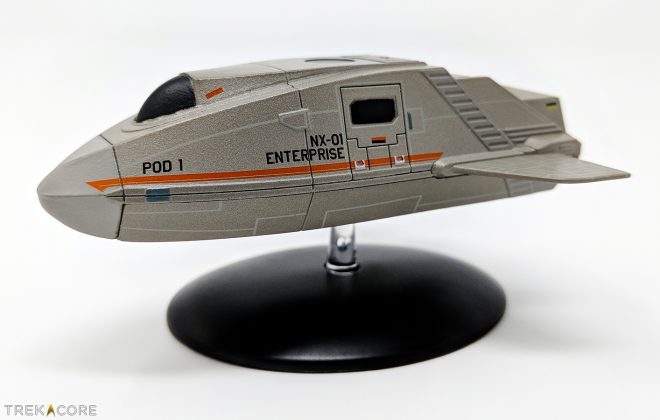
At last, Shuttlepod 1 joins the fleet! While I would have preferred this craft as a larger, standalone release similar to the Eaglemoss Delta Flyer or runabout models for such a well-loved vessel, but I’m glad to see this Enterprise -era ship finally get a display model.
Used throughout the run of Star Trek: Enterprise — and even glimpsed in archival footage from the Franklin in Star Trek: Beyond — the 22nd century shuttlepod appeared on-screen nearly 60 times during the run of the series, ferrying the crew of the NX-01 to planets and other destinations all through Archer’s captaincy.
From the pair of entry hatches on each side to the black and orange hull markings, the Shuttlepod 1 model is one I’ve been waiting for since Enterprise was still airing on UPN with detail to rival any other release from the Official Starships Collection to date.
The hull coloring is a bit more copper-colored than one might have expected, and not quite as silvery as its on-screen counterpart, and there’s a simple black circle on top in place of the expected docking hatch, which is a curious design change, but it doesn’t much detract from the overall look of the model. (I do wish the engines were ‘lit’ blue however!)
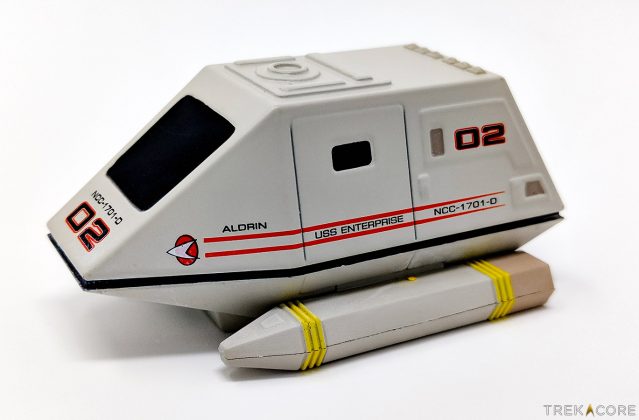
Curiously designated the Aldrin , a shuttle name not used during TNG’s run, the little Type-15 shuttle is such a relic of its time in Trek production, especially compared to the much larger and intricately-designed Shuttlepod from the Enterprise era, which was produced over a decade from this shuttle’s first appearance in TNG’s “Time Squared” back in 1989.
With the practical set piece just large enough to carry two actors, the two-inch Type-15 model is so tiny that it couldn’t even carry two Lego figures inside its diminutive hull — and that’s okay, because what this shuttle lacks in size it makes up for in molded detail and cleanly-applied red-and-black markings around the sides.
While the underside is a bit lacking in substance, the overall production on the attached warp nacelles and other features of the craft give this little pocket-sized ship character.
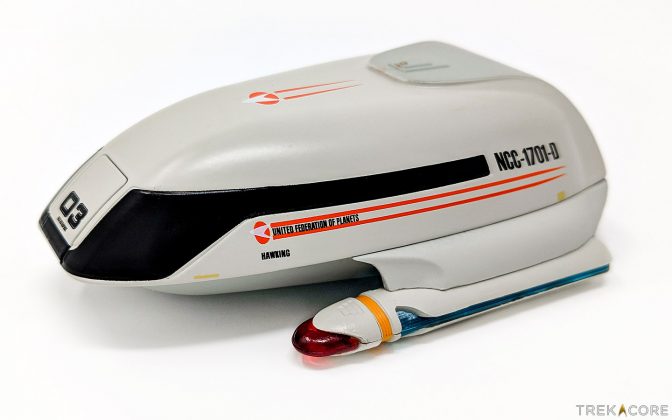
The Type-7 shuttle was a mainstay of the early days of The Next Generation , seen as early as Season 1’s “Coming of Age,” though the long side windows seen on this Eaglemoss model never appeared quite this way in any of the screen-used filming models (though it did originate in an early study model of the design ).
The extravagantly-curvy design of the Type-7 was never really able to be recreated will in a full-sized set piece, and frankly doesn’t even hold up that well as a miniature in the remastered TNG Blu-rays, but this model does a nice job of bringing the unusual shuttle to life for this release.
However, there’s a major labeling error on this shuttle, as the rear markings assign this ship to the USS ENTEPRISE, inadvertently dropping the first ‘R’ in the starship’s name. We’ve confirmed with Eaglemoss that a replacement run of this craft was not produced, making this a pretty disappointing element of a generally impressive set of ships.
This set completes the Next Generation -era shuttlecraft designs, leaving only the Voyager -era Type-8 shuttle yet unproduced, though with only two appearances it’s not likely that will be produced anytime soon unless Eaglemoss decides to move forward with a fifth shuttle set after their planned Kelvin release.
Keep coming back to TrekCore for more Official Starships Collection reviews, as we have a number of new releases to cover including the XL USS Voyager , the Enterprise XV-330 ringship , Andy Probert’s concept-version Enterprise -C , and of course the third shuttle set as well.
In the meantime, you can pick up the second shuttle set at Eaglemoss’ web store now.
In Eaglemoss’ US store, TrekCore readers can use promo code TREKCORE at checkout for 10% off any ‘Star Trek’ collectible purchase $60 or greater ( some exclusions apply).
- Shuttlecraft
- Star Trek VI: The Undiscovered Country
- Star Trek: Enterprise
- Star Trek: Generations
- Star Trek: The Next Generation
- The Official Starships Collection
Related Stories
Review — star trek: strange new worlds season 2 blu-ray, star trek: enterprise’s gary graham dead at 73, bluebrixx ends 2023 with 20+ new star trek brick-building kits, search news archives, new & upcoming releases, featured stories, our star trek: discovery season 5 spoiler-free review, star trek: discovery’s final adventure begins in april 2024, interview — star trek: lower decks’ mike mcmahan on moopsy, creating the orion homeworld, tuvix, and much more.
TrekCore.com is not endorsed, sponsored or affiliated with Paramount, CBS Studios, or the Star Trek franchise. All Star Trek images, trademarks and logos are owned by CBS Studios Inc. and/or Paramount. All original TrekCore.com content and the WeeklyTrek podcast (c) 2024 Trapezoid Media, LLC. · Terms & Conditions

IMAGES
VIDEO
COMMENTS
The Type 7 shuttlecraft was a type of Starfleet shuttlecraft carried on board Federation starships during the 24th century. The Type 7 shuttlecraft was introduced sometime prior to 2364. They were standard shuttlecraft aboard Galaxy-class, Excelsior-class, and Nebula-class starships in the mid to late 24th century. (TNG: "Coming of Age", "The Child"; Star Trek Generations) The Type 7 shuttle ...
Referred to as a Type 7 shuttle, it had a projected length of 8.5 m. As before, the series lacked the resources to build the complex shape of this shuttle as a full-scale prop. ... Like the shuttlecraft of Star Trek: The Original Series, the Space Shuttle orbiters were used interchangeably to carry crew, cargo or exploration payloads. In ...
An elite upgraded shuttle, used for short-range missions, Type-7 shuttlecrafts were in limited circulation in the mid-24th century, appearing on a moderate number of starbases and starships, including the Galaxy-class U.S.S. Enterprise-D.. Two wings of standard-issue (rare) Type 7 Shuttlecraft come pre-loaded as part of the standard equipment of the Ahwahnee Command Carrier.
The first thing to notice is that the Type-7 shuttle appeared only in TNG, and ever less frequently since the full-scale set of the Type-6 shuttle (based on the Galileo 5 from "Star Trek: The Final Frontier") was built for the fifth season. The real-world reason is that the curved surfaces of the Type-7 miniature turned out hard to reproduce faithfully in 1/1 scale, and especially the much too ...
Type 7. The producers liked the idea, but it proved too ambitious. "They built a shuttle that basically had square edges on it," said Probert. "Then they came up with the idea of getting into the shuttle from the side." ... Maybe you can help. I bought a playmates Star Trek TNG shuttlecraft and I wanted to repaint it to look more screen ...
Type 7 Shuttle: Type : Shuttlecraft: Unit Run : Feynman [1] - Active Hawking [2] - Active ... The Type 7 was introduced to a larger and heavier counterpart to the Type 6. In common with the 6, the Type 7 has a Duranium Tritanium hull which has greatly increased the strength and durability of the structure. ... Star Trek The Next Generation ...
The Galileo 5 type appeared in "Star Trek: The Final Frontier". Like all small shuttles of that time, this is supposed to be a sublight vessel. This isn't contradicted by on-screen evidence. ... This type of shuttlecraft is in use at least aboard ships of the Galaxy class and Excelsior class. Article: Variations of the Type-7 Shuttle Gallery ...
Type-7 shuttle - 3 views (Star Trek Fact Files) "Generations" shuttle - photo (Star Trek Mechanics) "Generations" shuttle - side (reconstructed by Reverend) ... Federation Shuttlecraft - and other small auxiliary vehicles. Variations of the Type-7 Shuttle - taking into account graphics, interiors, models, mock-ups.
The Type-7 was the first step in this direction, and is equipped for short-range warp travel. To offer comfort to its occupants, the shuttle contains a standard replicator system and sleeping compartments. The forward and aft compartments are separated by a small, informal living area that has a workstation and table.
Type 7 Shuttle: Type : Shuttlecraft: Unit Run : 1,217 built in total. 612 have been lost in all. Commissioned : 2359 - present: Dimensions : Length : 8.5 m [1] Beam : 3.6 m [2] ... Star Trek The Next Generation Technical Manual: Comment : Stated on page 161. Book : Star Trek The Next Generation Technical Manual: Series : Season :
The Type-7 Shuttlecraft is a shuttle, a craft designed for short-range missions. It was available for a limited time as a promotional release during the 30th Anniversary event of Star Trek: The Next Generation. This shuttle is equipped with a 360-degree Phaser Bank and Photon Torpedo Launcher.
The Type-4 Shuttle is based on the earlier Class-C shuttlecraft, a design that is also still seen in widespread use across the Federation. ... the Type-7 shuttle was the first wholly new personnel shuttle design in over 70 years. With its curved hull and spacious interior, it was a much higher performance vehicle than the Type-6 and generally ...
Sci-fi. Star Trek. List of named Federation shuttlecraft. See: Unnamed Federation shuttles Multiple concept sketches of Federation shuttles designed for Star Trek Beyond can be seen at Trekcore. [1] [2] Federation shuttlecraft at Memory Beta, the wiki for licensed Star Trek works.
Developed in the 2350's with technology from the Galaxy project, the Type 7 was a radical departure in established Starfleet shuttlecraft design. Larger than the commonplace Type 6, it featured a forward entrance ramp between the two viewing windows, more cabin space and far more powerful warp engines. Originally only intended to be used on Galaxy project-related starships (such as the Nebula ...
The Ahwahnee Command Carrier comes equipped with two hangar bays equipped with Type 7 Shuttlecraft, enhanced with extra sensor equipment. Launch Type 7 Shuttlecraft. When deployed, they harass enemies with Attack Pattern Beta and perform Close in Sensor Passes, debuffing foes' Damage Resistance Rating via both effects.
The Shuttlecraft Galileo - Part 1. By Steve Thomas. Today, in our guest blog, Star Trek enthusiast Steve Thomas chronicles the real-life travails of Star Trek's iconic shuttlecraft, the Galileo 1701/7. This is part one of an extensive two-part feature that includes photographs and video. September 8, 1966…or "Stardate: 6609.8," if you will.
We took a look at the first shuttle set back in August, and now we've got our hands on the second round of auxiliary craft models, which includes the Star Trek VI-era Executive Shuttle, the Type-7 and Type-15 shuttles of the Next Generation era, and the well-known Earth Starfleet shuttlepod from the days of Star Trek: Enterprise.
Star Trek Starships Collection Type 7 Shuttlecraft Issue 7 ReviewThanks for watching Join me--- https://twitter.com/theirishtrekkie--- https://www.facebook.c...